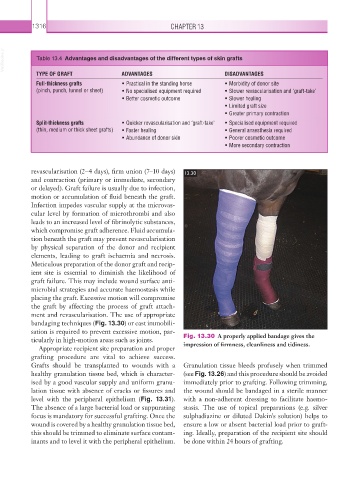Page 1341 - Equine Clinical Medicine, Surgery and Reproduction, 2nd Edition
P. 1341
1316 CHAPTER 13
VetBooks.ir Table 13.4 Advantages and disadvantages of the different types of skin grafts
TYPE OF GRAFT ADVANTAGES DISADVANTAGES
Full-thickness grafts • Practical in the standing horse • Morbidity of donor site
(pinch, punch, tunnel or sheet) • No specialised equipment required • Slower revascularisation and ‘graft-take’
• Better cosmetic outcome • Slower healing
• Limited graft size
• Greater primary contraction
Split-thickness grafts • Quicker revascularisation and ‘graft-take’ • Specialised equipment required
(thin, medium or thick sheet grafts) • Faster healing • General anaesthesia required
• Abundance of donor skin • Poorer cosmetic outcome
• More secondary contraction
revascularisation (2–4 days), firm union (7–10 days) 13.30
and contraction (primary or immediate, secondary
or delayed). Graft failure is usually due to infection,
motion or accumulation of fluid beneath the graft.
Infection impedes vascular supply at the microvas-
cular level by formation of microthrombi and also
leads to an increased level of fibrinolytic substances,
which compromise graft adherence. Fluid accumula-
tion beneath the graft may prevent revascularisation
by physical separation of the donor and recipient
elements, leading to graft ischaemia and necrosis.
Meticulous preparation of the donor graft and recip-
ient site is essential to diminish the likelihood of
graft failure. This may include wound surface anti-
microbial strategies and accurate haemostasis while
placing the graft. Excessive motion will compromise
the graft by affecting the process of graft attach-
ment and revascularisation. The use of appropriate
bandaging techniques (Fig. 13.30) or cast immobili-
sation is required to prevent excessive motion, par-
ticularly in high-motion areas such as joints. Fig. 13.30 A properly applied bandage gives the
Appropriate recipient site preparation and proper impression of firmness, cleanliness and tidiness.
grafting procedure are vital to achieve success.
Grafts should be transplanted to wounds with a Granulation tissue bleeds profusely when trimmed
healthy granulation tissue bed, which is character- (see Fig. 13.26) and this procedure should be avoided
ised by a good vascular supply and uniform granu- immediately prior to grafting. Following trimming,
lation tissue with absence of cracks or fissures and the wound should be bandaged in a sterile manner
level with the peripheral epithelium (Fig. 13.31). with a non-adherent dressing to facilitate haemo-
The absence of a large bacterial load or suppurating stasis. The use of topical preparations (e.g. silver
focus is mandatory for successful grafting. Once the sulphadiazine or diluted Dakin’s solution) helps to
wound is covered by a healthy granulation tissue bed, ensure a low or absent bacterial load prior to graft-
this should be trimmed to eliminate surface contam- ing. Ideally, preparation of the recipient site should
inants and to level it with the peripheral epithelium. be done within 24 hours of grafting.

